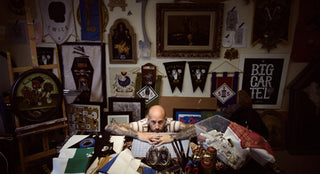Creative Minds, Creative Spaces” is a new series in which Tyler W. gives us an inside look into the process, surroundings, and motivations of creatives.
Whether you know him as Dan Christofferson or BeeTeeth, if you keep an eye on the world of design or illustration, you’ve likely stumbled across his work online. A self-proclaimed “overuser” of cryptic symbols from early Utah and Mormon history, Dan’s work is anything but ordinary. Currently residing in his hometown of Salt Lake City, Dan has certainly infused his Utah roots into his work.
When not working on the latest BeeTeeth design, Dan spends his time as the Community Director at Big Cartel, one of the leading e-commerce platforms for artists and makers alike. A quick look through Dan’s studio and you’ll see that he likes to keep busy. Having shown his work in a number of art galleries last year, he’s already hit the ground running for 2015 – including the launch of his brand new BeeTeeth Relics Shop.
Dan gives us a tour of his art studio, offers some insight into what drives his art, and speaks about welcoming his new son into his life.
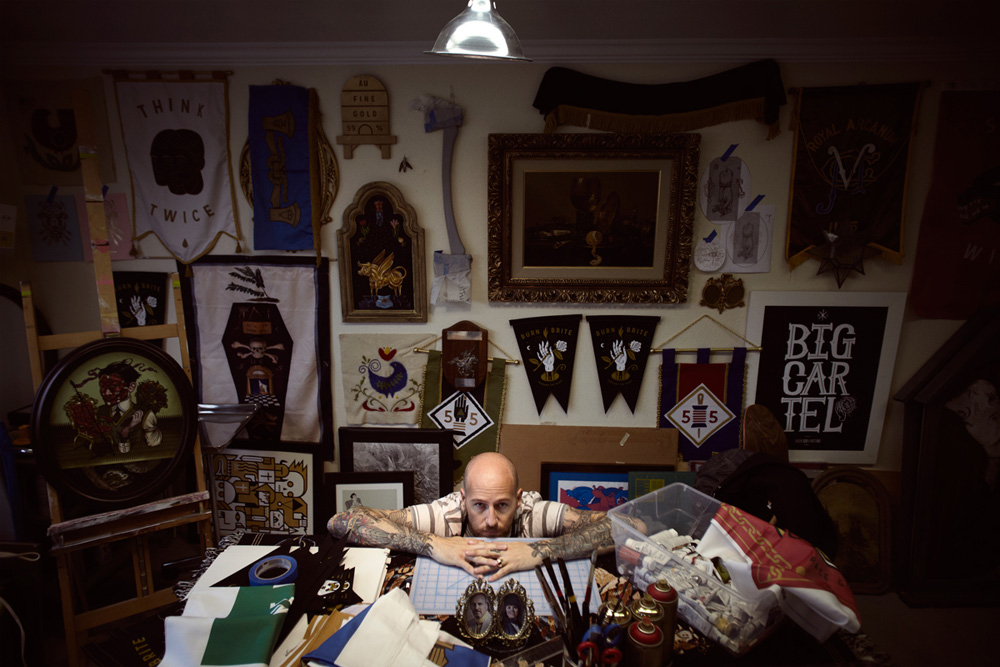
TYLER W: Please tell us about your journey into the world of art and design.
DAN CHRISTOFFERSON: I’m a storyteller and was always captivated by a good story. I grew up in a house with parents who read a lot, so I was surrounded by plenty of fantastic stories. That was probably my introduction to the world of art, design and illustration.
The first time I heard the story of Medusa, a mythical villain with snakes for hair, I lost it. My mind was racing with images and, luckily, when my mind gets racing, my typical response is to sketch and let it out. I started seeing drawing, sketching, and painting as a way to be a part of those fantastic stories.
I’d watch an episode of Teenage Mutant Ninja Turtles then grab a pencil and some paper and draw them in my own world, as characters I could control. It was powerful and extremely satisfying. The better I got at being able to render these elements, the more connected I was to these stories.
You grew up in Utah and still have some very strong roots to SLC. Can you speak about that connection?
Salt Lake is a hidden little gem of a city. Mostly known as an, “Oh yeah! I landed there once on a layover, and it looked really pretty,” kind of city.
Salt Lake was founded by an exiled religious group who had headed west to find some place to call their own. They worked their asses off [visitors likened them to a hive of busy bees] and built a city on the valley floor of the high western desert – all for themselves. That ethos has really stuck with people from Salt Lake City. We build beautiful things with our bare hands. We work hard and do it for us, with little or no attention from outside of the state.
Growing up in a city founded by a really conservative religious group has done wonders for the counterculture here in Utah. We have something to fight against and a lot of inspiring and unique work is created from that fight.
Do you feel that your upbringing in Utah has had a strong influence on your work?
Absolutely. My ancestors are immigrants who came here looking for some sort of rare religious truth. There’s a fierce independence that probably came from the need to defend themselves from the relative weirdness of their beliefs. That weirdness comes with stories. Lots of them, and they’re fantastic. Angels, swords, secret handshakes, huge temples, buried books: all the makings for elaborate, cryptic illustrations that could try to answer questions, or just probably end up asking hundreds more.
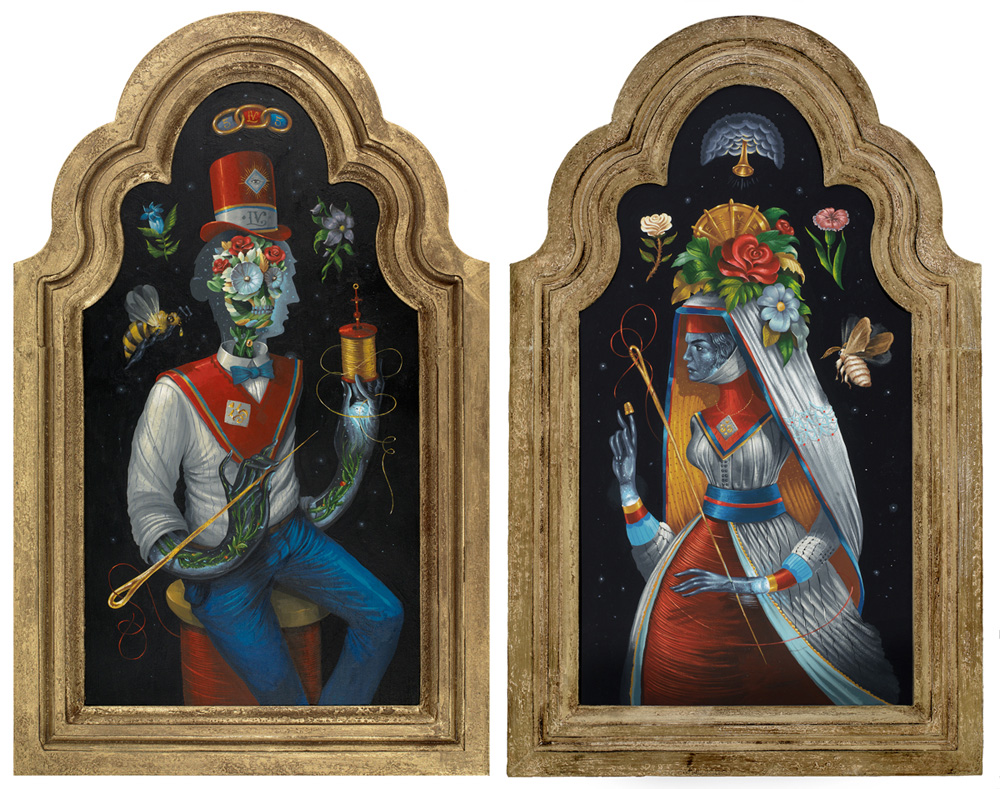

SLC isn’t particularly known for being a hot bed of creativity. What about the city’s creative scene do you wish more people knew?
I think it’s that focused, rebellious counterculture. Everything just seems to be powered by passion. We’re pretty far from all the big cities you’d typically connect with current culture. We have to build everything ourselves. If we want a big art show, or a famous designer to come to Salt Lake, we really have to fight for it; we have to plead out case. We’re getting used to that and even getting pretty good at it.
You’ve been at Big Cartel for over five years. How did you first get involved with the company?
Two of my best friends started Big Cartel. I watched them put so much work into it with no real expectations in the beginning. Watching that process of building something with such huge potential from nothing was really magnetic. They were building something that was pretty unique at the time: a simple tool that would allow someone like me to build a beautiful online shop in just a few minutes. Essentially, giving me one more way I could start to make a living being an artist.
I set up one of the very first stores and sold prints, drawings, and paintings. I was so excited about the potential that I couldn’t stop talking about it. It quickly became apparent that it made more sense for someone like me to preach what I was practicing. They brought me on to connect with their community of artists and help showcase the amazing new stores signing up with Big Cartel every day.
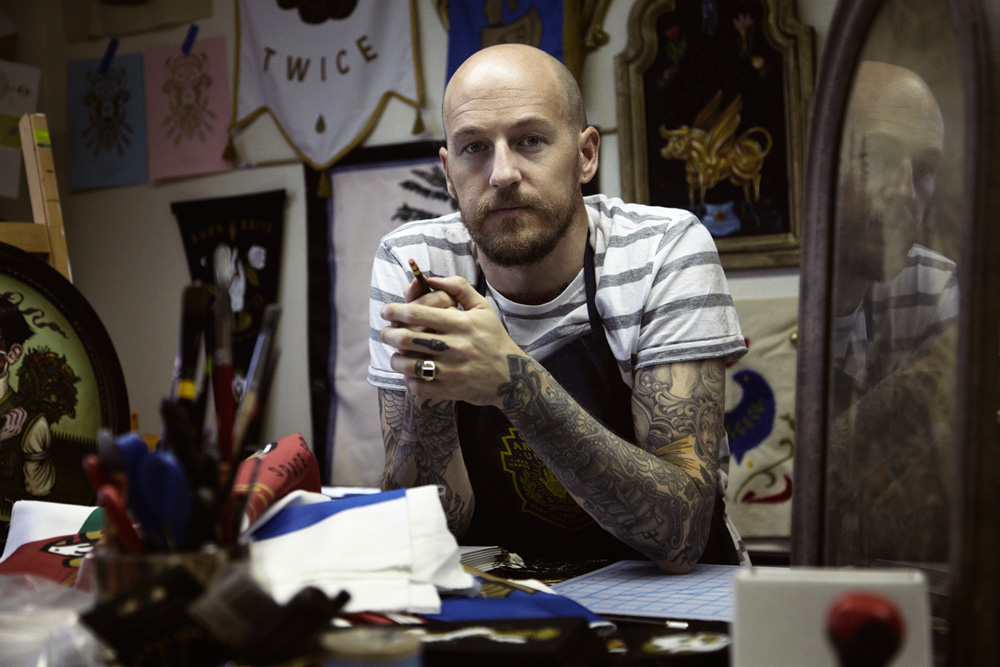
What has it been like as the company has grown over the years?
It’s really easy to forget that it’s a job. Almost ten years later and we’ve watched our community grow to over 600,000 artists. Our very first artist was a T-shirt designer who set up shop to promote and sell his first line of tees. He went on to be wildly successful and we were there to see his very first sale.
I remember celebrating our 500,000th artist, which was a band from Australia who was full of that same drive and DIY spirit embodied by our first store. It’s really rewarding to see that almost a decade in, we still connect with the same artists we set out to help in the first place.
Have you ever been tempted to make the move to a bigger design studio or agency?
I worked for a few bigger agencies when I was just out of art school. It was a great time, and I’m really proud of the work I did there, but I don’t really miss the long days. Plus, I definitely don’t miss tracking hours and designing for clients who don’t know me personally.
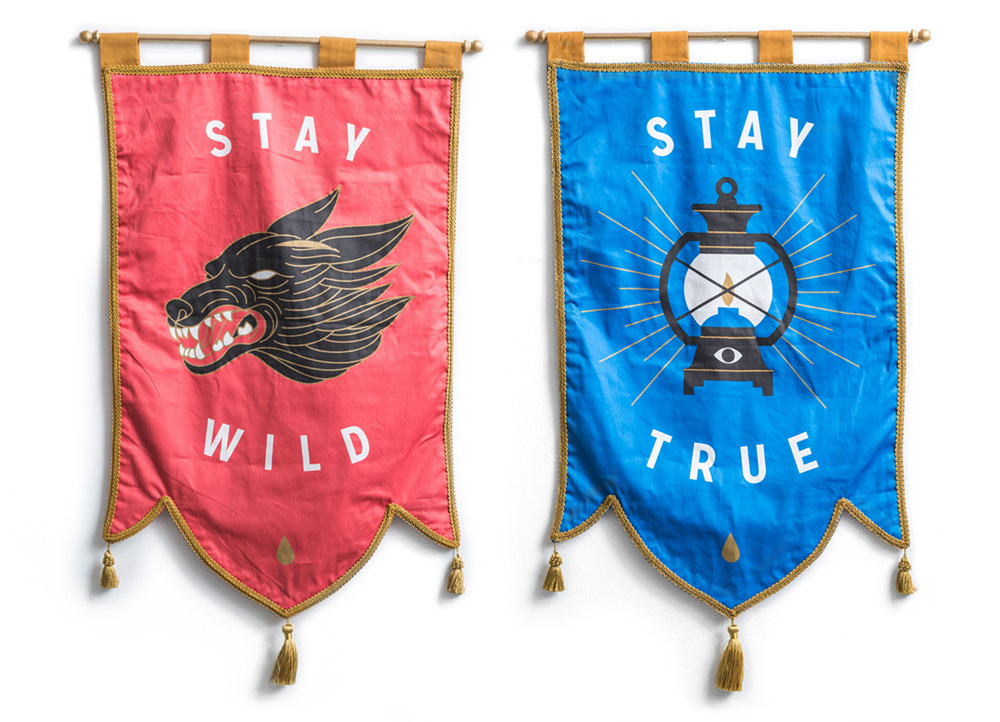
One of your latest projects was the BeeTeeth Relics Shop. How did that come to be?
I’ve always worked to make my art as accessible as possible. The people who appreciate my work aren’t always the people who can afford to spend $2,000 on a painting. However, screen-printing posters started to feel like a cop out to me. I felt like I could offer a line of products that were just as accessible, but with really unique silhouettes, using different materials, and boasting just as much detail and symbolism as a piece of fine art.
I’m enamored with the artifacts and aesthetics of secret societies and brotherhoods. They seem to tell a really complicated story without really ever explaining anything. I like that. We want to know so much about the unknown. These pieces play with that a little bit by introducing even more elements of the unknown while not really resolving much.
There is a very clear direction and vision to all of the pieces. Can you speak to that?
I’d love for someone to stumble on a collection of these pieces in 50 years without much context. I can imagine the confusion, followed by the desire to piece things together in a way that made some sense. The outcome would definitely be something I never intended, but something I think a lot of artists hope for: to have their work evolve into something entirely new simply by being experienced by new viewers.
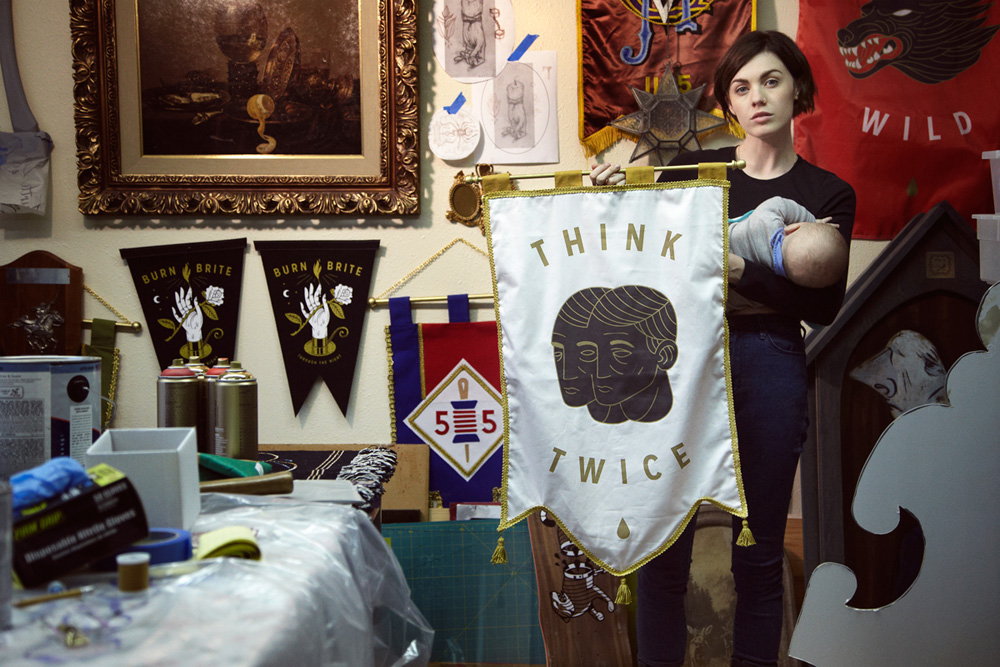
You seem to pull inspiration from some not so typical places. Where does it all come from?
I specifically remember a time a few years ago when I was struggling to find what made my work unique. I wasn’t necessarily the most talented or conceptual illustrator, and there were certainly much stronger designers and fine artists than myself, but I realized something that I could definitely hold up as my own — no one could combine the arcane and creepy symbols and stories from Utah and Mormon history like I could. And just like that, I decided to own that shit.
Is there an overall emotion or message you’re hoping your art communicates to the public?
I think it goes back to that same desire my ancestors had: finding some sort of truth. Digging through the icons and symbols of all this nonsense to come out with something that feels like real wisdom. I don’t think I’m offering anything uniquely true, but I do think I throw enough stuff out there that a hungry viewer can combine it into something that speaks specifically to them.
You’ve spoken before about taking more of a focus on slowing down, being grounded, and trying to stay in the present. Have you found this mindset to have a positive effect on your work?
Yeah, although I don’t think I could ever really actually slow down until now. My wife and I just had a baby boy, and I suddenly found myself caring much less about all the little races I was running before. It came at a perfect time and I couldn’t be more happy to have this little bear help me prioritize my life.

You’re involved in various capacities at a number of workshops (WMC Fest, etc.). Why do you think it is important to stay active with the creative community?
This may seem like the opposite of what should happen at a conference, but one of my favorite things about being in the same room with so many talented designers and artists is not talking at all about art. It’s a really comforting feeling to leave all your similarities as unspoken. We know we all love the same shit. We all spend most of our days doing relatively the same stuff. So, we finally don’t need to explain ourselves. We’re with our people and we’re free to let our creative minds relax a bit and wander to other places.
Over the years you’ve worked on a number of murals and installations. Is that something you enjoy doing?
Very much so. Larger pieces break me out of this little box I get stuck in. Literally.
My bones and joints ache from being slumped over a keyboard or a sketchpad all day. A big wall lets me stretch my arms while I draw, get up on my toes, and pace back and forth in front of a piece that requires more movement. Those larger movements encourage really confident lines.
I’m convinced we’d all be better at drawing if we allowed ourselves to draw on a larger scale. Our shoulders and backs would take some of the burden off of our hands and let the lines come out without trying to restrain them.
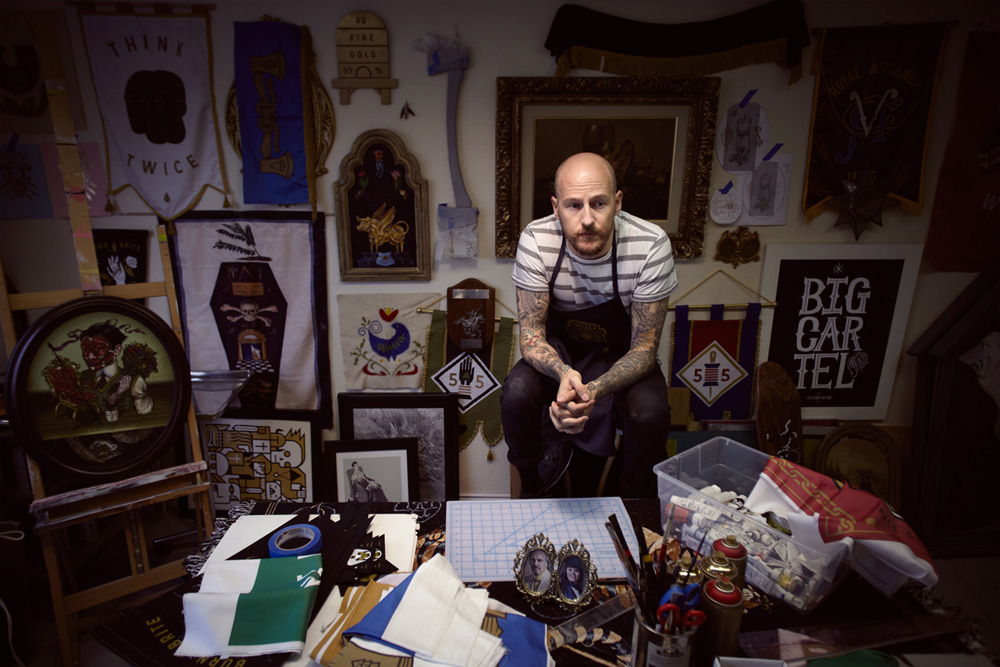
What is one of your favorite mediums to work in?
I love the contrast of vectors I can easily edit and undo vs. slow, acrylic paintings I have to plan out, build up, and hold my breath over.
What keeps you inspired to create?
Podcasts, Versailles, Victorian wallpapers, sunshine, swimming, animals, my wife, my son, paper with just the right tooth, and all-seeing eyes.
Please describe your creative process in ten words or less.
Riding my Falkor away from the Nothing.
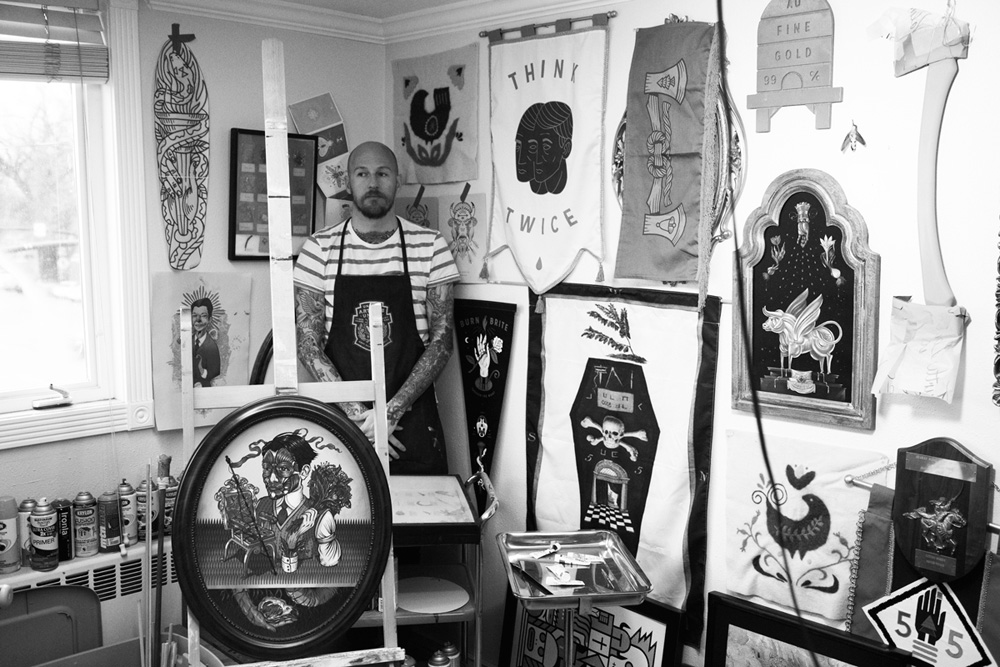
::
All photos by Steven Stone.
Keep up with Dan on Instagram @BeeTeeth and visit the BeeTeeth Relic Shop here.

